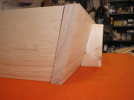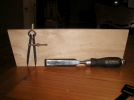Ok, let get this right, you have never cut a dovetail before? Jumping into the deep end are we? Ok, then, I think we need to discuss some things. I truly recommend that you work with sample corners such as this.

That way if or when you fail, and you will. Don't worry it's not anything that I haven't done before. You can cut away the offending joint and start a new. I do this type of thing all the time when I haven't cut a joint in a while, or I plane haven't done it before. I like setting up things and giving them a try before I commit to a project. It's a great learning tool. So please Jeff, go back to what I have posted and lets focus on one joint and do it until we have success. Trust me in this that is how I learned what I know is through practice, failure, and more practice, and then a little more failure. It keeps me humble, most days. So if you will step back and set up a practice joint up to where have posted, then we will proceed from there. Also if we need to step back and walk you through a dovetail then I guess we will.
That way if or when you fail, and you will. Don't worry it's not anything that I haven't done before. You can cut away the offending joint and start a new. I do this type of thing all the time when I haven't cut a joint in a while, or I plane haven't done it before. I like setting up things and giving them a try before I commit to a project. It's a great learning tool. So please Jeff, go back to what I have posted and lets focus on one joint and do it until we have success. Trust me in this that is how I learned what I know is through practice, failure, and more practice, and then a little more failure. It keeps me humble, most days. So if you will step back and set up a practice joint up to where have posted, then we will proceed from there. Also if we need to step back and walk you through a dovetail then I guess we will.



